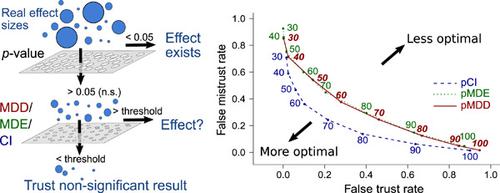当前位置:
X-MOL 学术
›
Environ. Toxicol. Chem.
›
论文详情
Our official English website, www.x-mol.net, welcomes your feedback! (Note: you will need to create a separate account there.)
The MDD Concept for Establishing Trust in Non-Significant Results - A Critical Review.
Environmental Toxicology and Chemistry ( IF 4.1 ) Pub Date : 2020-08-12 , DOI: 10.1002/etc.4847 Magdalena M Mair 1 , Mira Kattwinkel 2 , Oliver Jakoby 3 , Florian Hartig 1
Environmental Toxicology and Chemistry ( IF 4.1 ) Pub Date : 2020-08-12 , DOI: 10.1002/etc.4847 Magdalena M Mair 1 , Mira Kattwinkel 2 , Oliver Jakoby 3 , Florian Hartig 1
Affiliation

|
Current regulatory guidelines for pesticide risk assessment recommend that nonsignificant results should be complemented by the minimum detectable difference (MDD), a statistical indicator that is used to decide whether the experiment could have detected biologically relevant effects. We review the statistical theory of the MDD and perform simulations to understand its properties and error rates. Most importantly, we compare the skill of the MDD in distinguishing between true and false negatives (i.e., type II errors) with 2 alternatives: the minimum detectable effect (MDE), an indicator based on a post hoc power analysis common in medical studies; and confidence intervals (CIs). Our results demonstrate that MDD and MDE only differ in that the power of the MDD depends on the sample size. Moreover, although both MDD and MDE have some skill in distinguishing between false negatives and true absence of an effect, they do not perform as well as using CI upper bounds to establish trust in a nonsignificant result. The reason is that, unlike the CI, neither MDD nor MDE consider the estimated effect size in their calculation. We also show that MDD and MDE are no better than CIs in identifying larger effects among the false negatives. We conclude that, although MDDs are useful, CIs are preferable for deciding whether to treat a nonsignificant test result as a true negative, or for determining an upper bound for an unknown true effect. Environ Toxicol Chem 2020;39:2109–2123. © 2020 The Authors. Environmental Toxicology and Chemistry published by Wiley Periodicals LLC on behalf of SETAC.
中文翻译:

在非重要结果中建立信任的MDD概念-严格审查。
当前的农药风险评估监管指南建议,不重要的结果应辅以最小可检测差异(MDD)来补充,该最小可检测差异是一种统计指标,用于确定实验是否可以检测到生物学相关影响。我们回顾了MDD的统计理论,并进行了仿真以了解其特性和错误率。最重要的是,我们将MDD区分真假阴性(即II型错误)的技巧与2种备选方案进行了比较:最小可检测效果(MDE),一种基于医学研究中事后功率分析的指标;和置信区间(CI)。我们的结果表明,MDD和MDE的不同之处仅在于MDD的功效取决于样本量。此外,尽管MDD和MDE都具有区分误报和真正不存在效果的技巧,但它们的表现不如使用CI上限建立对不重要结果的信任。原因是,与CI不同,MDD和MDE均未在计算中考虑估计的效应大小。我们还表明,MDD和MDE在识别假阴性之间更大的影响方面并不比CI更好。我们得出的结论是,尽管MDD很有用,但CI对于确定是将不重要的测试结果视为真实阴性还是确定未知真实效应的上限来说是更可取的。MDD和MDE均未在计算中考虑估计的效应大小。我们还表明,MDD和MDE在识别假阴性之间更大的影响方面并不比CI更好。我们得出的结论是,尽管MDD很有用,但CI对于确定是将不重要的测试结果视为真实阴性还是确定未知真实效应的上限来说是更可取的。MDD和MDE均未在计算中考虑估计的效应大小。我们还表明,MDD和MDE在识别假阴性之间更大的影响方面并不比CI更好。我们得出的结论是,尽管MDD很有用,但CI对于确定是将不重要的测试结果视为真实阴性还是确定未知真实效应的上限来说是更可取的。2020年《环境毒理学》; 39:2109–2123。©2020作者。Wiley Periodicals LLC代表SETAC发布的《环境毒理学和化学》。
更新日期:2020-08-12
中文翻译:

在非重要结果中建立信任的MDD概念-严格审查。
当前的农药风险评估监管指南建议,不重要的结果应辅以最小可检测差异(MDD)来补充,该最小可检测差异是一种统计指标,用于确定实验是否可以检测到生物学相关影响。我们回顾了MDD的统计理论,并进行了仿真以了解其特性和错误率。最重要的是,我们将MDD区分真假阴性(即II型错误)的技巧与2种备选方案进行了比较:最小可检测效果(MDE),一种基于医学研究中事后功率分析的指标;和置信区间(CI)。我们的结果表明,MDD和MDE的不同之处仅在于MDD的功效取决于样本量。此外,尽管MDD和MDE都具有区分误报和真正不存在效果的技巧,但它们的表现不如使用CI上限建立对不重要结果的信任。原因是,与CI不同,MDD和MDE均未在计算中考虑估计的效应大小。我们还表明,MDD和MDE在识别假阴性之间更大的影响方面并不比CI更好。我们得出的结论是,尽管MDD很有用,但CI对于确定是将不重要的测试结果视为真实阴性还是确定未知真实效应的上限来说是更可取的。MDD和MDE均未在计算中考虑估计的效应大小。我们还表明,MDD和MDE在识别假阴性之间更大的影响方面并不比CI更好。我们得出的结论是,尽管MDD很有用,但CI对于确定是将不重要的测试结果视为真实阴性还是确定未知真实效应的上限来说是更可取的。MDD和MDE均未在计算中考虑估计的效应大小。我们还表明,MDD和MDE在识别假阴性之间更大的影响方面并不比CI更好。我们得出的结论是,尽管MDD很有用,但CI对于确定是将不重要的测试结果视为真实阴性还是确定未知真实效应的上限来说是更可取的。2020年《环境毒理学》; 39:2109–2123。©2020作者。Wiley Periodicals LLC代表SETAC发布的《环境毒理学和化学》。


























 京公网安备 11010802027423号
京公网安备 11010802027423号